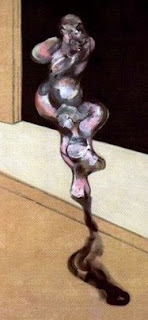Ades, Dawn, and Andrew Forge.
Francis Bacon, exhibition catalog, London: Tate Gallery, Thames & Hudson, 1985
Akerman, Luis Mariano.
The Grotesque in Francis Bacon's Paintings, M.A. thesis, 1999
Alley, Ronald and John Rothenstein.
Francis Bacon, introductory essay by Rothenstein, catalog raisonné by Alley, London: Thames & Hudson, 1964
Alphen, Ernst Van.
Francis Bacon and the Loss of Self (1992), Cambridge, Mass.: Harvard UP, 1993
Archimbaud, Michel.
Francis Bacon: In conversation with Michel Archimbaud (Entretiens avec Michel Archimbaud, 1992), London: Phaidon, 1993
Arles, Fondation Van Gogh, "Van Gogh vu par Bacon: la série des Van Gogh sur la route de Tarascon, July-October 2002,"
Artsversus,
http://www.artsversus.com/vangoghvuparbacon/ Boxer, David Wayne.
The Early Work of Francis Bacon, Ph.D dissertation, John Hopkins University, Baltimore, Maryland, 1975
Bragg, Melvyn, interviewer.
Francis Bacon (film), London Weekend Television, South Bank Show, interview and editing by Melvyn Bragg, prod. and dir. David Hilton, 1985
Brighton, Andrew.
Francis Bacon, London: Tate Gallery, 2001
Calhoun, Alice Ann.
Suspended Projections, Ph.D dissertation, University of South Carolina, 1979
Chiappini, Rudy.
Francis Bacon, exhibition catalog, Lugano: Museo d’Arte Moderna della Città di Lugano and Milan: Electa, 1993
Dagen, Philippe. « Un entretien avec Francis Bacon »,
Le Monde, 24 September 1987
Davies, Hugh Marlais.
Francis Bacon: The Early and Middle Years, 1928-1958, Ph.D. dissertation, Princeton University, 1975; New York and London: Garland, 1978
-----, and Sally Yard.
Bacon, New York: Abbeville, 1986
Deleuze, Gilles. “Francis Bacon: The Logic of Sensation,”
Flash Art 112, May 1983, pp. 8-16
-----.
Francis Bacon: Logique de la Sensation, 2 vols., Paris: Editions de la Différence, 1981
Demetrion, James T.
Francis Bacon, exhibition catalogue with essays by Lawrence Gowing and Sam Hunter, Washington, D.C., Hirshhorn Museum and Sculpture Garden: Smithsonian Institution and Thames & Hudson, 1990
Domino, Christophe.
Francis Bacon (1996), London: Thames & Hudson, 1997
Faerna, José Maria.
Bacon (1994), translated by Wayne Finke. New York: Harry N. Abrams, Inc., 1995
Farr, Dennis.
Francis Bacon: A Retrospective, exhibition catalog with contributions by Dennis Farr, Michael Peppiatt and Sally Yard, Yale Center of British Art and other venues, New York: Harry N. Abrams, Inc. in association with The Trust for Museum exhibitions, 1999
Farson, Daniel.
The Gilded Gutter Life of Francis Bacon, London: Vintage, 1993
Ficacci, Luigi.
Francis Bacon, Cologne: Taschen, 2003
Follet, Jean-Phillipe. "Francis Bacon à Beaubourg,"
Urban Desires, Vol. 2, Issue 5, September 1996
"Francis Bacon: Triptyques" (animation avec biographie, tableaux, références),
Artsversus, 2002,
http://www.artsversus.com/francisbacon Gale, Matthew.
Francis Bacon: Working on Paper, introduction by David Sylvester, London: Tate Gallery, 1999
Gowing, Lawrence.
Francis Bacon: Recent Paintings, exhibition catalog, New York: Marlborough-Gerson Gallery, 1968
Harrison. Martin.
In Camera Francis Bacon: Photography Film and the Practice of Painting, Thames & Hudson, London, 2005
Hergott, Fabrice.
Francis Bacon, exhibition catalog, Paris: Centre Georges Pompidou, 1996
Hughes, Robert. ‘Singing within the Bloody Wood’,
Time, July 1 1985, pp. 54-55
Leiris, Michel. « Ce que m’ont dit les peintures de Francis Bacon », in: exhibition catalog,
Francis Bacon : Recent Paintings, London: Marlborough Fine Art, 1968
Leiris, Michel.
Francis Bacon, Full Face and in Profile (Francis Bacon, face et profil, 1983), English tr. John Weightman, London: Thames & Hudson, 1988
Muñoz-Molina, Antonio.
Francis Bacon: Pinturas 1981-1991, exhibition catalog, Madrid : Galería Marlborough, 1993
Ogden, Perry,
7 Reece Mews Francis Bacon’s Studio, introduction by John Edwards, London: Thames & Hudson, 2001
Peppiatt, Michael.
Francis Bacon: Anatomy of an Enigma, London: Weidenfeld & Nicholson, 1996
Russell, John.
Francis Bacon, London: Thames & Hudson, 1971. Revised and Updated 1993
Schmied, Wieland.
Francis Bacon, Munich and New York: Prestel, 1996
Seipel, Wilfried.
Francis Bacon and the Tradition of Art, exhibition catalog, Vienna: Kunsthistorisches Museum, 2003
Sinclair, Andrew.
Francis Bacon: His Life and Violent Times, London: Sinclair-Stevenson, 1993
Sylvester, David.
Interviews with Francis Bacon, London: Thames & Hudson, 1993
Sylvester, David.
Francis Bacon: Important Paintings from The Estate, exhibition catalog with essays by Sam Hunter and Michael Peppiatt
Sylvester, David.
Francis Bacon: Papes et autres figures, exhibition catalog, Paris : Galerie Lelong, 1999
Sylvester, David.
Francis Bacon in Dublin, exhibition catalog with contributions by Grey Gowrie, Louis le Brocquy, Anthony Cronin and Paul Durcan, Dublin: Hugh Lane Municipal Gallery of Modern Art and Thames & Hudson, 2000
Sylvester, David,
Looking back at Francis Bacon, London: Thames & Hudson, 2000
Trucchi, Lorenza.
Francis Bacon (1975), tr. John Shepley, London: Thames & Hudson, 1976
Vanel, Hervé.
Francis Bacon: Entretiens, 1971-1991, Paris: Carré, 1996
Zweite, Armin.
Francis Bacon: The Violence of the Real, exhibition catalog, Düsseldorf: Kunstsammlung Nordrhein-Westfalen, 2006
 ...Turning Figure, oil on canvas, 1963
...Turning Figure, oil on canvas, 1963








